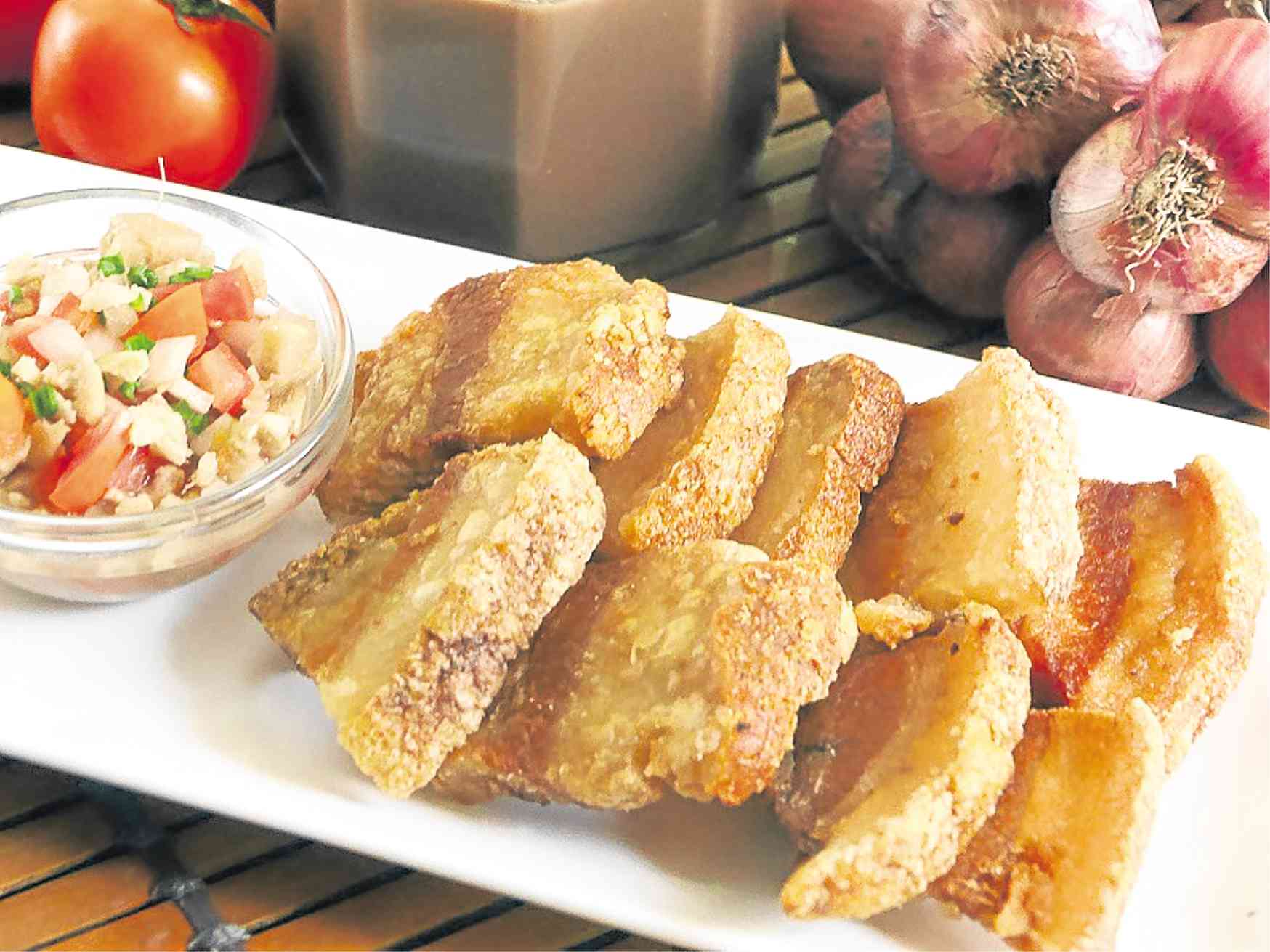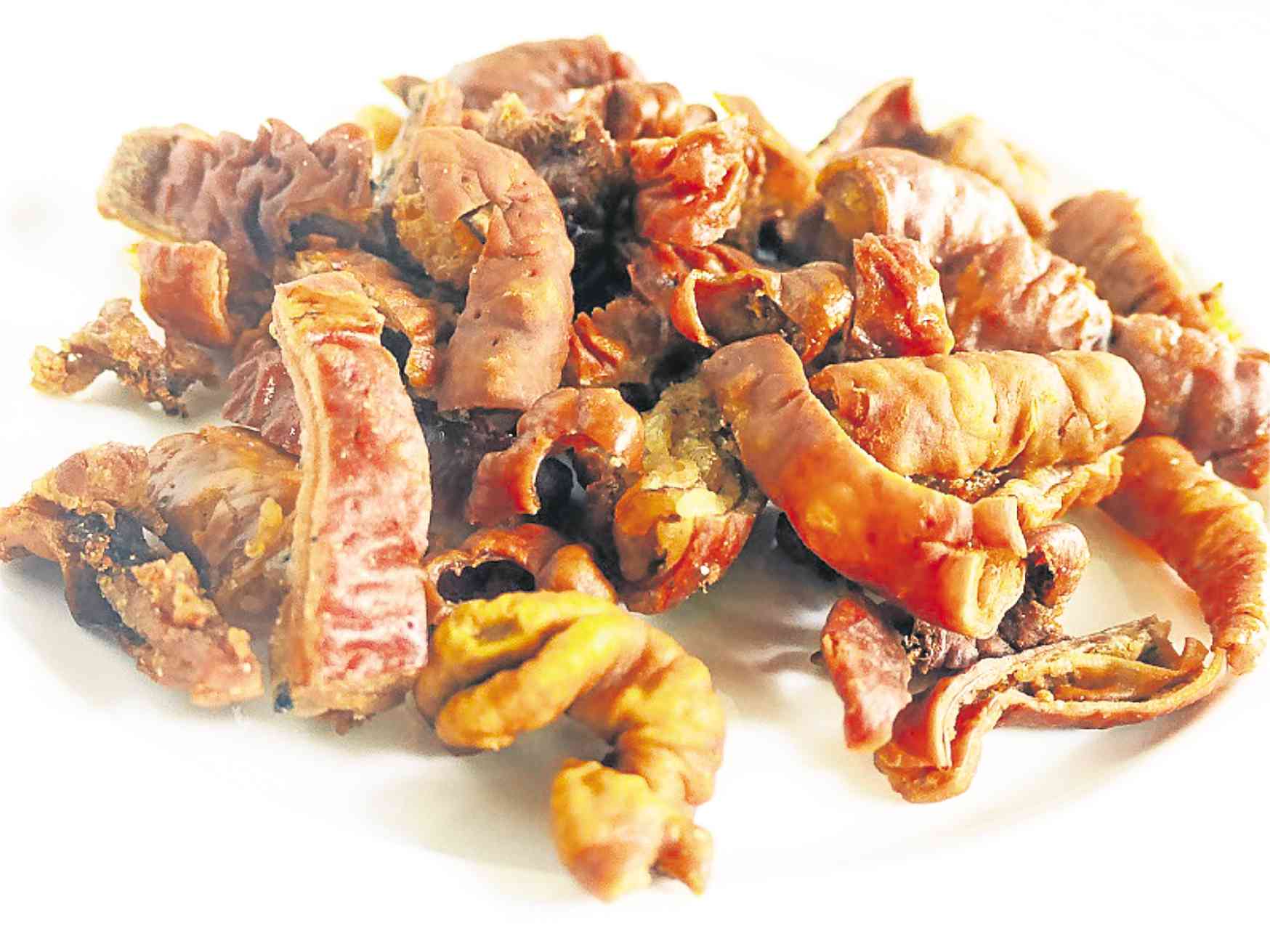
The topic was chicharon, deep-fried pork belly and rind, with Claude Tayag presiding in an event at Unilab’s MusKKat (Museo ng Kaalamang Katutubo). Tayag is a chicharon connoisseur who documents every chicharon he samples anywhere.
The meals in his Pampanga home always come with a side dish of chicharon. He seems to have a radar to detect if there’s chicharon in the house. In Spain, on our way out of the restaurant after dinner, he spotted chicharon bulaklak in the tapas counter.
The bulaklak is made of pork innards—that part that supports the intestines. But while local chicharon bulaklak is deep-fried, the Spanish version seemed to have been boiled, then cooled, with sebo or cooled fat (tallow) coming out.
In the Philippines, chicharon must be crunchy, mostly salty and, when dipped in vinegar, yields the sour counterpoint.
It is sometimes paired with achara (pickled vegetable) or other sauces.

‘Bagnet’
Tayag’s talk covered chicharon history—spanning the authentic and the pretenders, its various names, as well as health issues related to eating chicharon.
It is the local names that lead Tayag to believe that chicharon was known in the Philippines even before the Spanish colonial period. This, no matter that Antonio Sanchez de Mora, chief of the Archivos General de Indias in Seville, Spain, claimed that “chicharron originated in the Andalusian region of Southern Spain where most of the colonial seafarers came from.”
Traditional bakeries such as Panaderia de Molo in Iloilo still use rendered pork fat (lard) for cookies. The crunchy bits left on the surface, called tulapo, are sold to restaurants to be used in their dishes. This is also known as chicharon Bisaya.
There’s bagnet in Ilocos, but the all-skin version in Ilocos Sur is called okilas, dipped in a blood sauce of dinardaraan (dinuguan or blood stew).
Pititian is how small pieces of chicharon are called in Pampanga. Its root word titi means “to fry in its own fat.”
The old Bicol-Spanish dictionary defines agas or tacas as “que quedan de la manteca,” or what remains of the rendered fat.

‘Chicharon bituka’
There are other types of chicharon, depending on which part of the pork is used. Aside from the bulaklak, there’s chicharon bituka— bagis-bagis or bagbagis to Ilocanos.
There’s back fat, which has a bit of meat attached to the fat—chicharon laman or Ilocos’ bagnet.
There’s the all-skin version which, because eating it is just like biting into air, is called bula (bubble) or sometimes the more derogatory terms tanga (stupid) or bingi (deaf).

Health issues
The health issues are linked to the fat, salt, and MSG content. But it doesn’t seem to bother people—some say that the fat and oil are dissolved in the cooking and what remains is fiber.
Tayag also mentioned chicharon as a source of collagen—protein that helps maintain skin elasticity. Or so we hope.
But even if chicharon predated the Spanish rule, there’s no ignoring that Spanish chicharon counterparts still exist in the mercado (public market).
There’s torreznos de Soria, cured, deep-fried bacon from Soria in Spain.
The most intriguing chicharon looked like corned beef.
During a tour of jamon Serrano factories in Spain, Tayag and I learned that R. Lapid’s Chicharon in the Philippines orders backfat from these factories.
‘Fishcharon’
There are chicharon pretenders, said Tayag. Carabao skin chicharon is available in the Visayas, especially Leyte. Fishcharon is fish skin.
Butsiron is chicken esophagus.
Even sawa (snake) skin is made crispy. Kropek and fried macaroni are made with flour, starch and transfat.
In Santol, La Union, the specialty is from the family of Daisy Sayangda-Olivar—deep-fried pork rind with a coating of a red sauce, almost like ketchup.
And then there’s “proven”—a part of chicken innard between the esophagus and the gizzard called proventiculus—which started in Los Baños, Laguna, is usually thrown away when the chicken is dressed, covered in cornstarch and then deep-fried.
Each chicharon variety was dipped in several kinds of Mama Sita vinegar (cashew, coconut nectar, distilled cane vinegar, sinamak, sukang Iloko, anghang sarap which has chilli in cane vinegar) and Tayag’s own Aslam Atbu or coconut vinegar.
It was a chance to compare chicharon and vinegar. My tablemates favored bagnet and pititian with coconut nectar and Tayag’s chili-spiked vinegar.
Email [email protected]













































